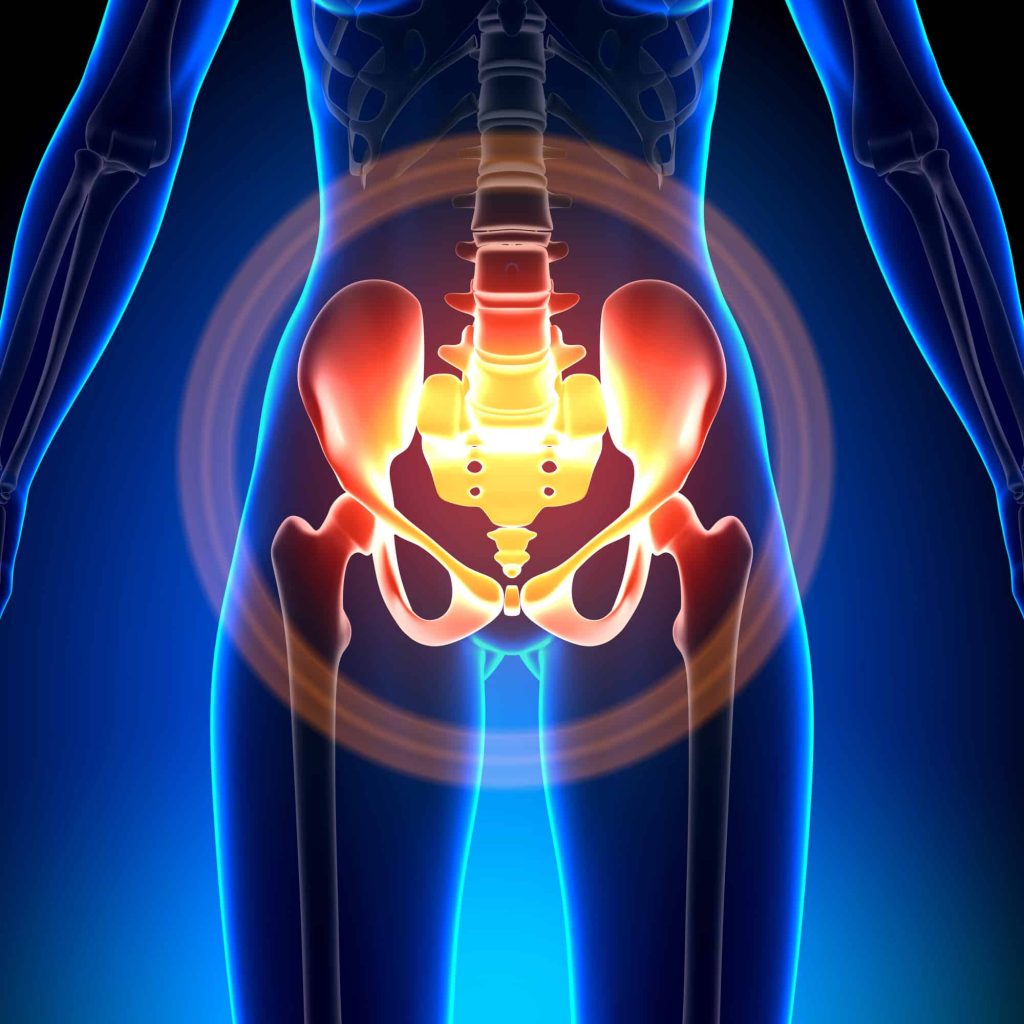
When coughing, laughing, or sneezing, do you experience urinary “leakage”?
If so, you could be one of the many women in Australia and worldwide who suffers from a weak pelvic floor.
Although the symptoms of a weak pelvic floor can be embarrassing, it’s not usually a severe medical condition, and we can assist the problem with therapeutic exercise.
But without proper treatment, weakness in the pelvic floor muscles can increase your risk of pelvic organ prolapse.
Where one or more of your pelvic organs drop into or out of your vaginal canal or rectum, causing a range of uncomfortable symptoms, along with a range of other pelvic floor disorders.
More Blogs From Focus Osteopathy
Why Does My Hip Pain Linger After Pregnancy?
How Pregnancy Can Cause Knee And Back Pain
How Does Modern Day Life Affect Posture?
What Is The Pelvic Floor?
The “pelvic floor”, as it’s conveniently referred to by doctors, physical therapists and patients alike, is made up of muscle and connective tissue that attaches to the pelvic bones.
Its main job is to support the pelvic organs – the bladder, intestines, urethra, and rectum, in both sexes. In women, specifically, the term “pelvic organs” also include the vagina, cervix, and uterus.
The simplest way to imagine the pelvic floor is to picture a bunch of muscles in a hammock shape inside your pelvis. When these muscles contract, they pucker up when we try to stop gas or urine from escaping.
What Is The Function Of The Pelvic Floor?

The pelvic floor muscles play a vital role in our daily body functions.
These all-important muscles provide support to all the organs within the pelvic region. But that’s not all they do.
They also play a critical role in hip movement, core stability, sexual arousal and achieving orgasm.
In addition, they’re an integral part of a healthy functioning reproductive system, pregnancy, and complication-free delivery. They also provide stability to our trunk and hips while standing or walking.
But what happens when things go wrong?
Women’s pelvic floor muscles can commonly become weak during pregnancy and natural childbirth, causing discomfort and pain, and sometimes (in severe cases) pelvic organ prolapse.
Other reasons for dysfunction and weakness to occur in the pelvic floor muscles are:
- A sedentary lifestyle
- Obesity
- Carrying heavyweights
- Surgery
- Aging
- Menopause
- Irritable Bowel Syndrome (IBS), constipation, irregular bowel movements
- Endometriosis
- Interstitial Cystitis
How To Locate Your Pelvic Floor Muscles

Do you know where your “pelvic floor” is?
You probably have a fair idea where it is, but to locate the exact spot, try this:
– Stop your urine flow midway and release it to start again after 2-3 seconds.
Do this a few times next time you go to the bathroom, and you’ll feel for yourself exactly where the pelvic floor muscles are and how to activate them.
However, if that doesn’t work for you, you could try:
– Lying on the floor and inhaling with your feet flat on the floor and your knees bent at approximately 90 degrees.
Next, slowly exhale while pulling in your lower abdomen and trying to squeeze the muscles of the urethra.
As you do when trying to prevent gas or urine from escaping, or you can concentrate on squeezing the muscles around the vagina instead if it’s challenging to visualize the urethra.
Hold either of these positions for 2-3 seconds and release. When you do this, you will feel the sensation of the pelvic floor muscles releasing.
If getting down on the floor is difficult, you can also activate the pelvic floor muscles while standing by squeezing the muscles that control your urine flow.
You will likely feel a contraction around your anus when you do this, standing specifically and often in seated positions.
This connection with the anus is because the pelvic floor muscles stretch across the bottom of your pelvis, so when you contract the pelvic floor, it affects the urethra, vagina, and rectum.
If you feel the contraction in your anus, too, you know the contraction is correct. This sensation is because you’re activating the pelvic floor muscles.
Why Are Strong Pelvic Floor Muscles Important?

Proper engagement of the pelvic floor muscles leads to better abdominal contractions.
So if you’re physically active and want to improve your core strength, you will see vastly better results if you work on strengthening your pelvic floor muscles with your core strength.
But it’s not all about strengthening.
If you can learn to relax and release the pelvic floor muscles correctly, you can maintain healthy, normal functioning of the pelvic floor and prevent issues with urinary incontinence and pelvic organ prolapse in the future.
This control over the pelvic floor is especially important as we age.
For this reason, we recommend that women of all ages regularly check the contraction and function of their pelvic floor muscles – and seek treatment if the muscles feel weak.
You can do this easily and make it part of your daily routine when walking, standing, or sitting throughout the day.
However, remember not to stress the muscles out too much as too much tension can have the opposite effect and lead to pain and other problems in the pelvic region.
What Is Pelvic Floor Dysfunction?

If our pelvic floor muscles get weak or their function is affected, they are unable to provide support to the organs inside the pelvic region.
This lack of support is what leads to pelvic floor disorders.
These disorders can include bladder issues, fecal/urinary incontinence, discomfort during sex or pelvic organ prolapse.
While many women suffer from this condition, limited medical awareness and the sometimes vague symptoms mean it is often missed or misdiagnosed.
So it is difficult to approximate how many women have this disorder.
Sadly, many women who suffer from pelvic floor dysfunction usually attribute it to aging and childbirth. Instead, they suffer in silence and don’t seek help.
Overall, medical researchers estimate that around one in four women experiences pelvic floor muscle dysfunction – with around 50% of women having pelvic floor issues while young and of childbearing age.
But as we grow older, that number increases exponentially.
Forecasters predict that as many as 70% of women will experience pelvic floor dysfunction due to unhealthy lifestyles and rising obesity in the future.
It’s a commonly held belief that pelvic floor dysfunction only affects women.
However, women are at greater risk due to pregnancy, labour, and childbirth. But 16% of men also suffer from pelvic floor muscle dysfunction.
What Are The Symptoms Of Pelvic Floor Dysfunction?

- Painful spasms in the pelvic region
- Urinary or fecal incontinence
- Pain in the lower back region
- A feeling of fullness/ pressure in the pelvic area
- Frequent urge to urinate or pain when urinating
- Urinary bladder seeming full despite visiting the bathroom
- Genital pain or discomfort in the pelvic area
- Pain when having sex
The good news is that there is no need for surgery in most cases.
Instead, we can help relieve discomfort and pain with non-surgical treatments like therapeutic exercises, hands-on osteopathy techniques, and guided physical therapy.
What Are The Benefits of Pelvic Floor Therapy?

As with other muscles in the body, our pelvic floor muscles function more optimally if they are strong and can perform “complete contractions”.
In addition, a strong pelvic floor helps maintain and support the proper functioning of the reproductive system and bowel and bladder function.
Finally, a strong pelvic floor provides stable support to all the organs in the pelvic bowl. Studies show that improving pelvic function is so vital that it can even improve your overall quality of life.
There is also a direct link between the pelvic floor muscles and sexual functioning.
In men, individuals who have pelvic floor therapy see improvement in ejaculation and erectile dysfunction issues.
In women, medical studies show that fully contracting the pelvic floor muscles can improve libido and the intensity of orgasms.
Pelvic floor therapy is also a helpful addition to the overall treatment plan for overactive bladder issues by helping to improve control over involuntary contractions of the bladder and therefore reducing urinary incontinence.
If you suffer from pelvic organ prolapse, you will also particularly benefit from building the strength of your pelvic floor muscles and potentially avoiding surgery.
It can also help you if you suffer from pain in the lower back, pelvic pressure, or bowel/urinary incontinence.
Talk To An Osteopath

If you’re experiencing symptoms that you believe might be connected to your pelvic floor muscles.
But you’re not sure what osteopathy is or how we might be able to help you, our “Talk To An Osteopath First” service is for you.
This free telephone consultation is an opportunity for you to learn more about our services and talk to an osteopath about your issues first, without any financial commitment.
Just complete the short form, and we’ll be in touch to arrange your complimentary appointment.

